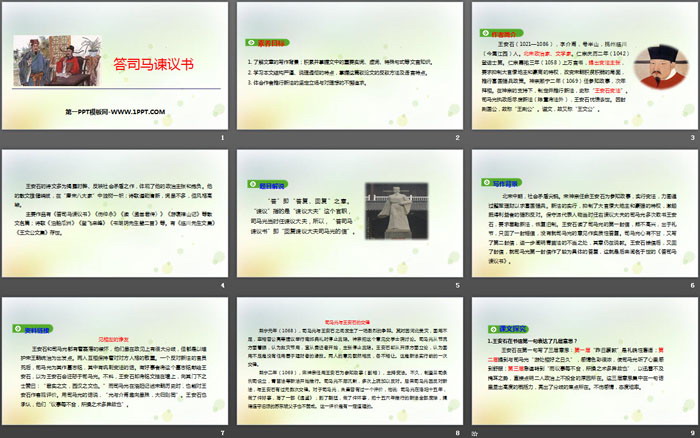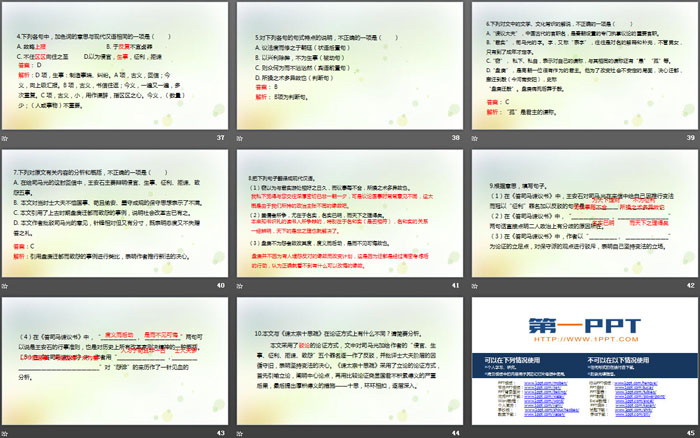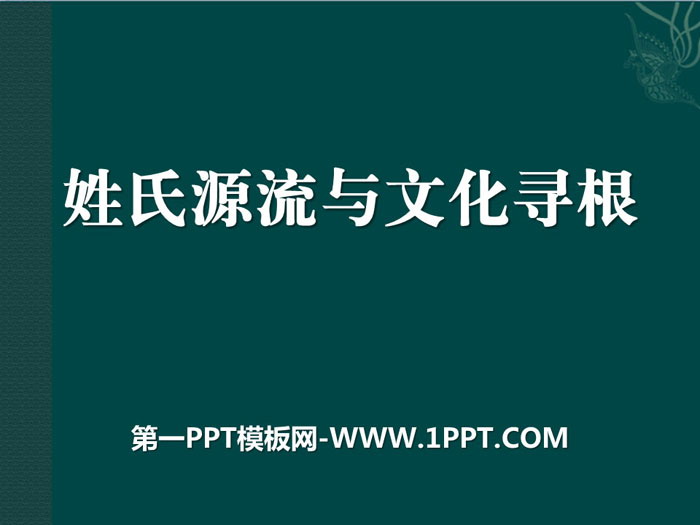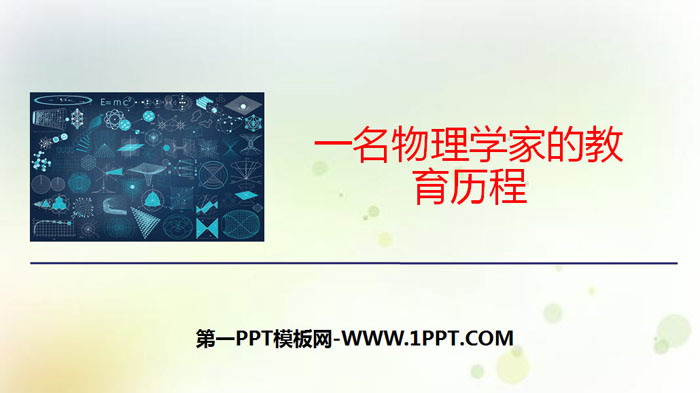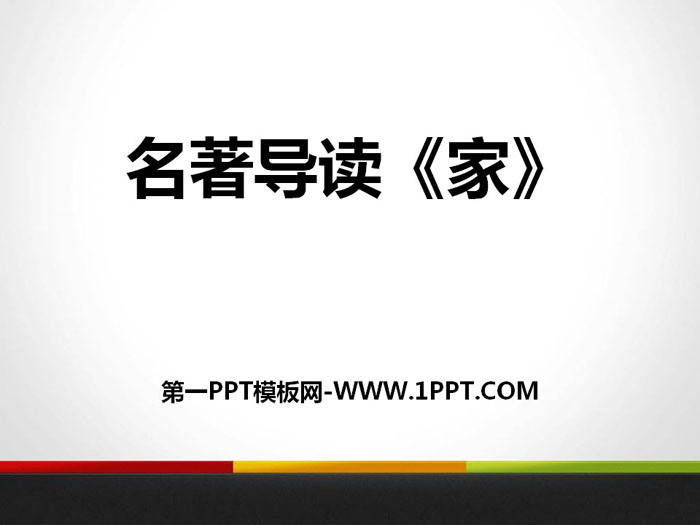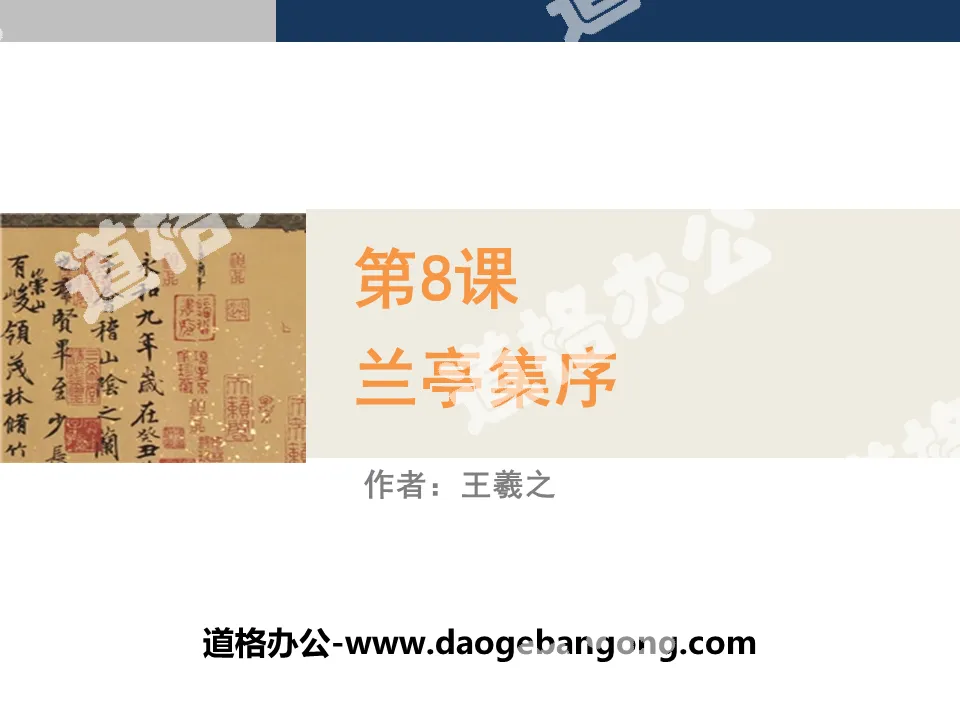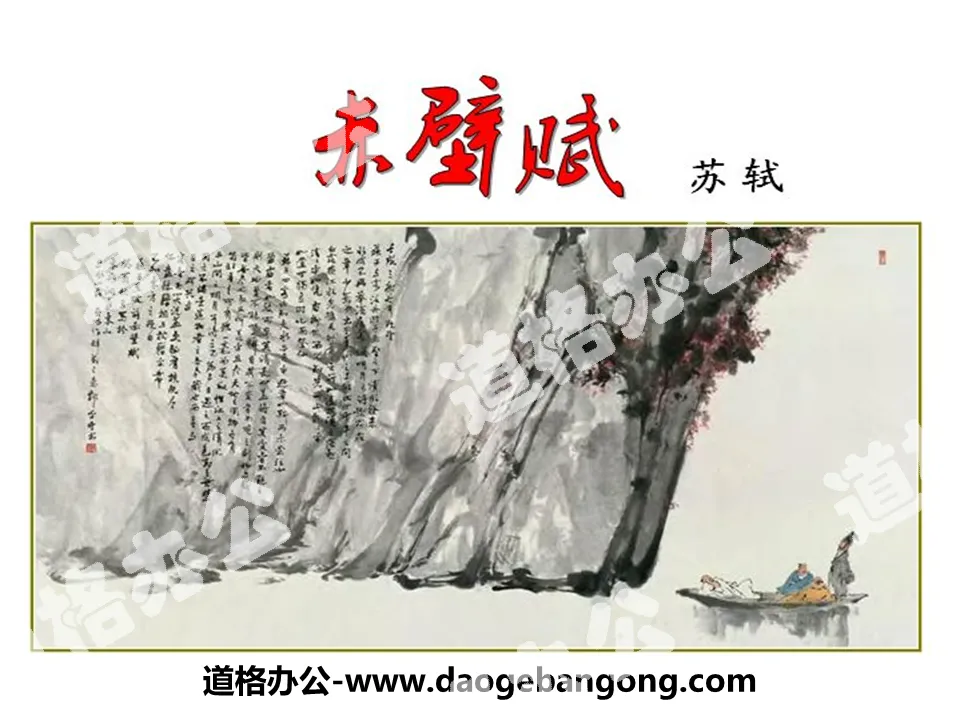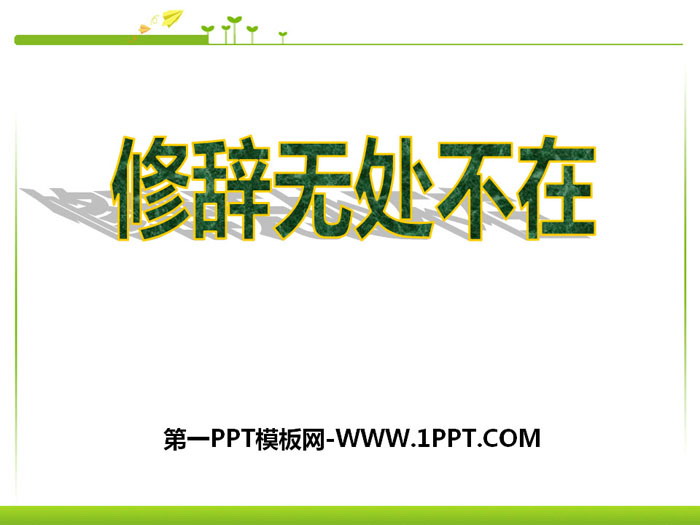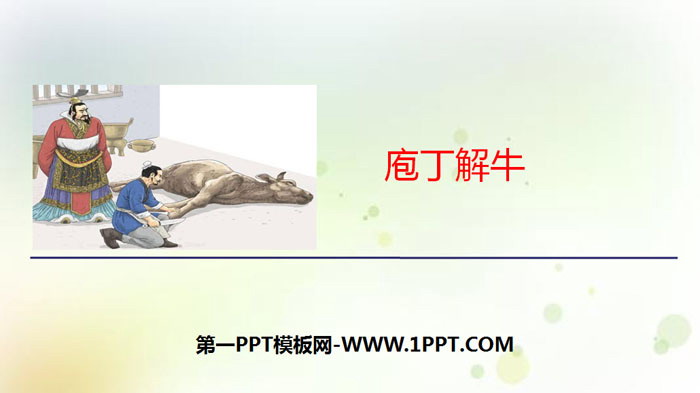
| Category | Format | Size |
|---|---|---|
| People's Education Press High School Chinese Compulsory Course 2 | pptx | 6 MB |
Description
"Reply to Sima's Remonstrance" PPT
Part One: Literacy Goals
1. Understand the writing background of the article; accumulate and master the important content words, function words, special sentence patterns and other classical knowledge in the article.
2. Learn the characteristics of this article’s rigorous structure and thorough reasoning, and master the refutation methods and language features of this article.
3. Understand the author’s firm stance in promoting the new law and his unremitting pursuit of ideals.
Reply to Sima's Remonstrance PPT, the second part: Introduction to the author
Wang Anshi (1021-1086), courtesy name Jiefu and nickname Banshan, was a native of Linchuan, Fuzhou (now part of Jiangxi). Politician and writer of the Northern Song Dynasty. In the second year of Renzong Qingli's reign (1042), he became a Jinshi. In the third year of Jiayuan reign of Renzong (1058), he wrote tens of thousands of words, proposing reforms, calling for curbing the privileges of big bureaucrats, landlords and wealthy businessmen, changing the situation of poverty and weakness in the Song Dynasty, and implementing the policy of enriching the country and strengthening the army. In the second year of Shenzong Xining's reign (1069), he was appointed as the counselor of political affairs and became the prime minister the following year. With the support of Shenzong, a new law was formulated and implemented, which was known as the "Wang Anshi Reform" in history. After Sima Guang came to power, all new laws (except for the general law) were abolished, and Wang Anshi died in sorrow and anger. Because he was granted the title of Duke of Jing State, he was called "Wang Jing Gong". Posthumous title, so he is also called "Wang Wengong".
Most of Wang Anshi's poems expose current ills and reflect social contradictions, reflecting his political opinions and ambitions. His prose is powerful and upright, unique among the "Eight Great Masters of the Tang and Song Dynasties"; his poetry is powerful and fresh, and although there are not many words, his style is high.
His main works include famous prose pieces such as "Reply to Sima's Remonstrance", "Injury to Zhongyong", "Reading the Biography of Mengchang Jun", "A Journey to Baochan Mountain"; poems such as "Mooring the Boat on Guazhou", "Climbing Feilai Peak" and "Book Lake". "Two Poems by Mr. Yin on the Wall" and so on. There are "Collected Works of Mr. Linchuan" and "Collected Works of Wang Wengong" extant.
Question explanation
"Answer" means "reply, reply". "Jianyi" refers to the official position of "Jianyi doctor". Sima Guang was the Jianyi doctor at that time, so "reply to Sima Jianyi's letter" means "reply to the letter of Jianyi doctor Sima Guang".
writing background
In the mid-Northern Song Dynasty, social conflicts were acute. Emperor Shenzong of the Song Dynasty appointed Wang Anshi as a counselor in political affairs, implemented reforms, and tried to enrich the country and strengthen the army through military reorganization and financial management. The implementation of the new law suppressed the privileges of big bureaucrats, landowners and powerful powerful people, and aroused strong opposition from vested interests. Sima Guang, a representative figure of the conservatives who was serving as the right admonishment official at the time, wrote to Wang Anshi many times, demanding that the new law be dismissed and the old system restored. Wang Anshi read Sima Guang's first letter and was quite unhappy. Out of etiquette, he only replied with a text message and did not make a substantive reply to Sima Guang's opinions. Sima Guang was unwilling to give up and wrote a second letter to further clarify the inappropriateness of the Qingmiao Law, and his intention was still to preach. After receiving the letter, Wang Anshi replied to another letter and gave a more specific reply to Sima Guang's first letter. This is what later became the world-famous "Reply to Sima Guang's Remonstrance".
Reply to Sima's Remonstrance PPT, the third part: text exploration
1. How many meanings did Wang Anshi express in the first sentence of the letter?
Wang Anshi wrote three meanings in the first sentence: the first level "Yesterday I was taught" is a polite formula; the second level mentioned that he and Sima Guang "were getting along well for a long time", which was very emotional and made Sima Guang listen. I felt comfortable in my heart; the third level quickly turned to "Every time there is disagreement about the discussion, the techniques used are different", which directly pointed out the reason why the two people did not agree with each other politically with lightning speed. These three levels of meaning are concentrated in one sentence, showing a high degree of generalization and highlighting the focus of disagreement. Don't be sentimental and be candid.
2. What is the important content of the first paragraph of the article? what's the effect?
Mainly explain the reason and purpose of writing this letter. Because there were differences between the two of them, they wrote letters to express their positions and attitudes. Out of politeness, I’ll start with my words of reply—from the initial draft of “I don’t need to identify myself one by one” to the fact that I shouldn’t be careless and sloppy in correspondence, now I want to “be specific”—explain the reasons in detail, and then move on. Enter the text.
3. What views does the author refute Sima Guang? What kind of person can we tell from this that Wang Anshi is?
Invading officials, causing trouble, extracting profits, and refusing to remonstrate, causing resentment and slander in the world. He refuted the charges imposed on him one by one, and used four unquestionable sentences of "not for...", which showed Wang Anshi's demeanor as a politician and reformer.
4. What is the purpose of using "Pangeng's Relocation" in the article?
It is intended to illustrate that "the number of complaints" is not the only criterion for judging right and wrong; as long as you are sure that you are doing the right thing, you will not give up the implementation of the new law because of others' slander; at the same time, it also shows that you will fight against all opinions and insist on reform. Expressed his determination to adhere to the reform.
Reply to Sima's Remonstrance PPT, Part 4: Summary of the theme
The argument of the whole article is based on Sima Guang's accusation that the new law "intrudes on officials, causes trouble, expropriates profits, and refuses to remonstrate, causing resentment and slander in the world." He points out that "what Confucians fight is especially about name and reality. The name and reality are clear, and the world's It makes sense." This shows that the reform is correct, and Sima Guang's attacks are inconsistent with the name and are all fallacies. The article refutes Sima Guang's fallacies point by point, thus refuting the shortcomings of conservatives who are indifferent to national affairs and stick to the rules. It shows the author's determination to persist in reform, never to be swayed by rumors and common sayings, and his firm attitude to persist in reform.
Reply to Sima's Remonstrance PPT, Part 5: In-depth exploration
1. This article is a refutation. What point of view does the author aim to refute? How to develop the refutation?
①The point of view refuted by this article is that "invading officials, causing trouble, expropriating profits, and refusing to remonstrate will cause resentment and slander in the world."
② In response to Sima Guang's accusation of "invading officials, causing trouble, expropriating profits, and refusing to remonstrate, causing resentment and slander in the world", the author first refutes one by one that "he was ordered by the master, discussed laws and regulations, and revised them to the court, and taught them to officials. Invading officials; promoting the government of the previous kings to promote benefits and eliminating disadvantages, not to cause trouble; managing the world's finances, not to collect profits; preaching against evil, making things difficult for others, not to refuse advice." In this way, there is reason, evidence and restraint, but "invading officials, causing trouble, expropriating profits, and refusing to remonstrate" becomes something out of nothing, and Sima Guang's argument loses its foundation.
2. Under the severe situation, what is Wang Anshi’s attitude towards reform? What statements reflect this attitude?
① Wang Anshi insisted on reform and never looked back.
② "To measure one's righteousness and then act is to not regret it", "If you say that today you should do nothing and just stick to what you have done before, that is not what someone dares to know" and other sentences embody Wang Anshi's attitude.
3. After Wang Anshi refuted Sima Guang's point of view, why did he make another comment and say, "A certain person has been convicted of his crime"?
The author plays hard to get and takes a step aside, saying that if the other party blames himself for being in power for a long time and failing to help the emperor do great things and benefit the people, then he will be guilty. Although this is not the true intention of this article, it is a sincere statement. Then he reversed the situation and expressed his attitude head-on: "If you say today that everything is indifferent and just stick to what you have done before, then I don't dare to know." There is a sharp edge in the euphemistic tone, and he points out the point in one sentence. The ideological essence of the conservatives represented by Sima Guang directly penetrated the opponent's vital points, exposing his true colors and leaving him speechless.
4. The argument method of this article is refutation, and the methods of refutation are various. Let’s try to analyze it based on the text.
① Direct refutation, such as "Managing money for the world, not for profit".
② With the help of arguments, such as "Someone said that he was ordered by the master, discussed the laws and revised them to the court, and taught them to the officials, not to invade the officials." Here is a favorable basis, indicating that he is not acting arbitrarily, but Being ordered by the emperor is a law discussed by the imperial court, which points out that this is not a personal behavior, but a reasonable and legal one.
③Cite historical facts to refute, such as "Pangeng's move was caused by the people who complained, not just the scholar-bureaucrats of the imperial court; Pangeng did not change his attitude because of the complaints, and then acted after measuring righteousness. This is why he did not see any regrets." Here, the allusion of Pan Geng's move to the capital is used to express that he will not change his position due to rumors. He not only tactfully refutes the other party's accusations, but also expresses his firm determination to reform. The entire rebuttal is clear and powerful, concise and to the point.
Reply to Sima's Remonstrance PPT, Part Six: Combination of Classical Chinese Knowledge
1. Important pronunciation.
① Rape () ② Slander ()
③ Difficult () Ren () people ④ Xu () resentment
⑤ Pan Geng () ⑥ Meeting ()
2. General meaning.
①No more self-identification one by one _______________________
②Don’t be rude_________________________
3. Different meanings in ancient and modern times.
① Report the reason briefly
②Don’t be reckless because of repetition
③Then why are the people doing something other than being violent?
④It causes resentment and slander in the world
Reply to Sima’s Remonstrance PPT, Part 7: Homework
1. Explain the highlighted words in the following sentences.
(1) Every disagreement in the discussion: _______________
(2) There are many different techniques used. Technique: _______________
(3) Even if you want to be strong: _______________
(4) Therefore, today’s Taoism is: _______________
(5) Execution of the previous king’s government: _______________
2. The correct statement about the punctuated words in the following sentences is ( )
① I hope Junshi may see forgiveness ② Now Junshi meets the teacher ③ Takes orders from the master ④ Discuss the laws and repair them to the court
A.①② have different meanings, ③④ have the same meaning B.①② have different meanings, ③④ have different meanings
C.①② have the same meaning, ③④ have different meanings D.①② have the same meaning, ③④ have the same meaning
3. Please point out the types of conjugations of punctuated words in the following sentences and explain them.
(1) The theory of warding off evil ____________________
(2) Nanrenren____________________
(3) Use advantages to eliminate disadvantages____________________
(4) Manage finances for the world, not for profit ____________________
(5) Follow the common customs, flatter others and do good deeds ____________________
(6) Failed to help the great people to anoint the people____________________
(7) As it is said, nothing should be done today __________________
Keywords: Free download of PPT courseware for high school Chinese compulsory course 2 published by the People's Education Press, PPT download of Answers to Sima's Remonstrances, in .PPT format;
For more information about the PPT courseware "Answers to Sima's Admonitions", please click on the "Answers to Sima's Admonitions" PPT tab.
"Reply to Sima's Remonstrance" PPT courseware 2:
"Reply to Sima's Remonstrance" PPT Courseware 2 The book has two meanings in the title of the classical Chinese text. One is a noun, used in letters and documents. For example, Wang Anshi's "Reply to Sima's Remonstrance", Wu Jun's "A Letter to Zhu Yuan", and Lin Juemin's "A Letter to His Wife" may refer to letters or documents...
"Reply to Sima's Remonstrance" PPT courseware:
"Answers to Sima's Admonitions" PPT courseware Wang Anshi, courtesy name Jiefu and nickname Banshan, was from Linchuan, Fuzhou. He retired to Jiangning in his later years and was granted the title of Duke of Jing. He was known as Duke Wang in the world. He was a famous politician and writer in the Northern Song Dynasty and one of the Eight Great Masters of the Tang and Song Dynasties. one. His works include "Collected Works of Mr. Linchuan". Write..
File Info
Update Time: 2024-06-30
This template belongs to Chinese courseware People's Education Press High School Chinese Compulsory Course 2 industry PPT template
"Reply to Sima's Remonstrance" PPT Simple campus recruitment activity planning plan summary enterprise and institution recruitment publicity lecture PPT template is a general PPT template for business post competition provided by the manuscript PPT, simple campus recruitment activity planning plan summary enterprise and institution recruitment promotion Lecture PPT template, you can edit and modify the text and pictures in the source file by downloading the source file. If you want more exquisite business PPT templates, you can come to grid resource. Doug resource PPT, massive PPT template slide material download, we only make high-quality PPT templates!
Tips: If you open the template and feel that it is not suitable for all your needs, you can search for related content "Reply to Sima's Remonstrance" PPT is enough.
How to use the Windows system template
Directly decompress the file and use it with office or wps
How to use the Mac system template
Directly decompress the file and use it Office or wps can be used
Related reading
For more detailed PPT-related tutorials and font tutorials, you can view: Click to see
How to create a high-quality technological sense PPT? 4 ways to share the bottom of the box
Notice
Do not download in WeChat, Zhihu, QQ, built-in browsers, please use mobile browsers to download! If you are a mobile phone user, please download it on your computer!
1. The manuscript PPT is only for study and reference, please delete it 24 hours after downloading.
2. If the resource involves your legitimate rights and interests, delete it immediately.
3. Contact information: service@daogebangong.com
"Reply to Sima's Remonstrance" PPT, due to usage restrictions, it is only for personal study and reference use. For commercial use, please go to the relevant official website for authorization.
(Personal non-commercial use refers to the use of this font to complete the display of personal works, including but not limited to the design of personal papers, resumes, etc.)
Preview

